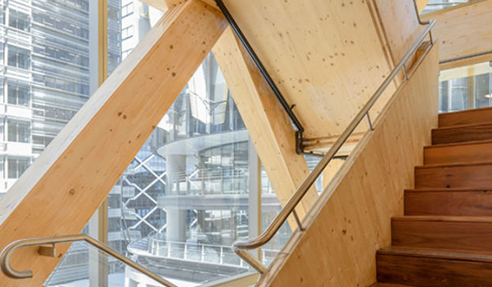Sustainable Architecture: How to Build a Green City through Green Innovations Over the years, sustainable architecture has emerged as a primary focus of the modern building industry. It has advanced to become a standard factor in all phases of the building cycle, from planning to future use and even disposal. Not limited to just sustainable materials, environmentally-friendly building incorporates the use of advanced technologies and energy-efficient products that benefit people and the environment in the long run. Glue-Laminated, Laminated Veneer, and Cross-Laminated Timbers Timber is regarded as the only renewable building material that is also durable, safe, and efficient and hence is highly recommended in for construction. Instead of adding pollution to the atmosphere, timber-made structures extract and absorb CO2 from the air. Through carbon sequestration, wood consistently retains a large number of carbons even after it becomes a timber. The use of timber products is already progressing in Australia. In the continuous pursuit for more sustainable and cost-effective structures, the Forest and Wood Products Australia (FWPA) and the Australian Building Codes Board's technical committee permitted the use of an integrated timber building systems in all building renovation and construction. It includes the utilisation of glue-laminated, laminated veneer, and cross-laminated timbers. Modular Building Construction The perfect example of an aesthetically pleasing, highly functional, and environmentally friendly structure, modular building construction is going mainstream. Modular construction is a prefabrication system where the building is completed off-site through 'modules'. The same materials and standards of traditional buildings are utilised but finished in much less time. Little known to many, modular building construction reduces the waste by an incredible margin, as confirmed by the Waste & Resources Action Program (WRAP) from the United States. Engineered to exact specifications, the modules are transported completed and ready to install on site. It is easy to place and move from one place to another without disturbing the environment with dust and debris. Not only great for reducing construction waste modular buildings are also commonly installed with energy efficient and green-rated products such as insulated glasses, solar panels, and more. Completed under controlled conditions, modular construction does away with energy consumption spent on the traditional building process. Smart Water Meters and Smart Water Tanks The innovation of smart water meters is driven by the strong need for an effective solution against water leakage. Initiated by the tech giant Telstra, the integrated water meter reading meters run using Narrowband Internet of Things (NB-IoT), enabling real-time tracking of water supply and loss measurement. Through smart leak sensors, possible moisture or water content within slabs is easily detected through immediate notifications and alerts, hence is easier to redress. A Smart Water Tank is also another way to prevent wasteful use of water. Through a wireless powered water storage solution, one can easily manage and monitor water usage, tank levels, and control pumps using a wireless keypad. Learn more about building green cities with sustainable architecture at DesignBUILD from 14-16 May 2019 at the International Convention Centre, Sydney. Head over to www.designbuildexpo.com.au for more information.
|
02 9275 9200
|


 DesignBUILD 2020 Postponed Until October
DesignBUILD 2020 Postponed Until October Planning your Kitchen Renovation:
Planning your Kitchen Renovation: DesignBUILD 2020: A Focus on the Latest
DesignBUILD 2020: A Focus on the Latest Prefabricated Construction at
Prefabricated Construction at Architectural Excellence with Interior
Architectural Excellence with Interior 3D FDM Printing: What are the Important
3D FDM Printing: What are the Important Insulated Buildings and Cooler Streets
Insulated Buildings and Cooler Streets How Construction Software is Changing
How Construction Software is Changing DesignBUILD 2019: Commercial Platform
DesignBUILD 2019: Commercial Platform Evolution of Smart Cities at DesignBUILD
Evolution of Smart Cities at DesignBUILD DesignBUILD 2019: Speaker Series
DesignBUILD 2019: Speaker Series What's on at DesignBUILD 2019?
What's on at DesignBUILD 2019? The Rise of Engineered Timber Buildings
The Rise of Engineered Timber Buildings Stay Relevant: How to Handle Rapid
Stay Relevant: How to Handle Rapid Trending Lower: Australian Building
Trending Lower: Australian Building Innovative Building Ideas from the
Innovative Building Ideas from the Global Building and Construction
Global Building and Construction Key Drivers of Prefab and Smart Modular
Key Drivers of Prefab and Smart Modular 3D Printing Sustainable Construction
3D Printing Sustainable Construction Sustainable Water Storage: Preparing for
Sustainable Water Storage: Preparing for
